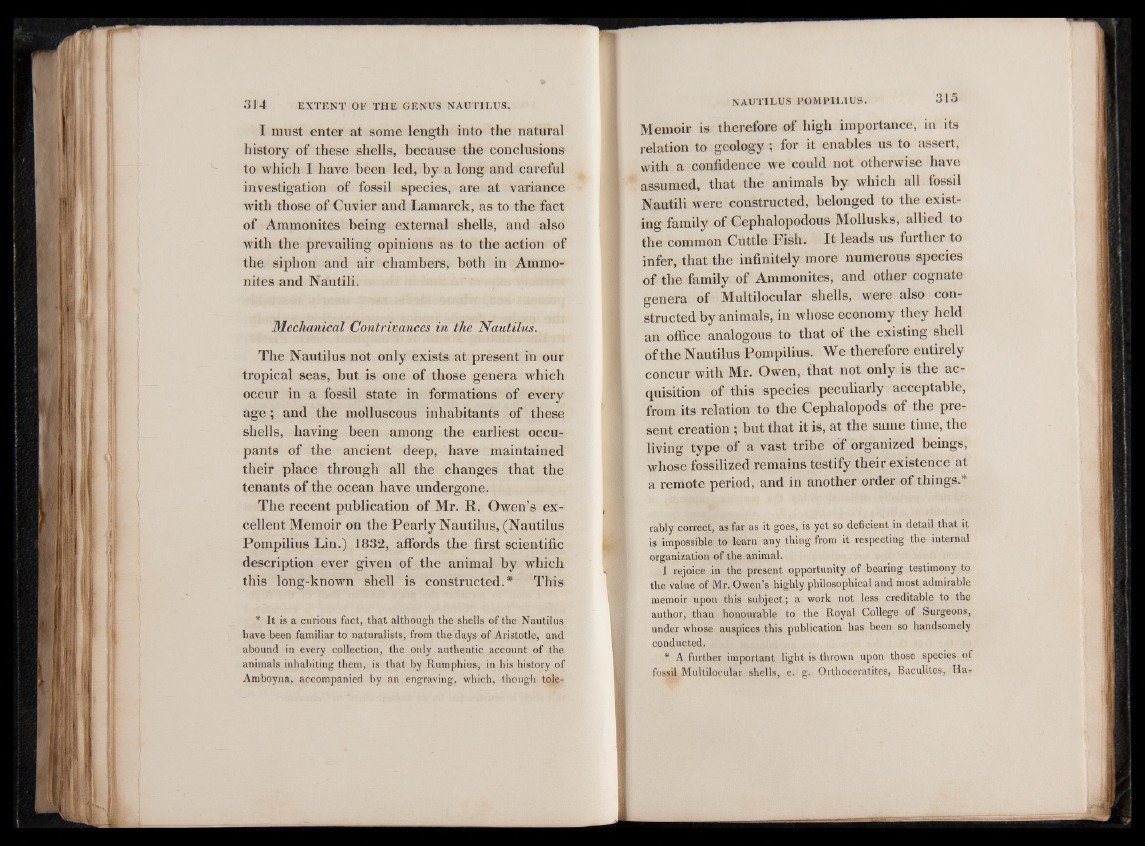
I must enter at some length into the natural
history of these shells, because the conclusions
to which I have been led, by a long and careful
investigation of fossil species, are at variance
with those of Cuvier and Lamarck, as to the fact
of Ammonites being external shells, and also
with the prevailing opinions as to the action of
the siphon and air chambers, both in Ammonites
and Nautili.
Mechanical Contrivances in the Nautilus.
The Nautilus not only exists at present in our
tropical seas, but is one of those genera which
occur in a fossil state in formations of every
ag e ; and the molluscous inhabitants of these
shells, having been among the earliest occu-r
pants of the ancient deep, have maintained
their place through all the changes that the
tenants of the ocean have undergone.
The recent publication of Mr. R. Owen’s excellent
Memoir on the Pearly Nautilus, (Nautilus
Pompilius Lin.) 1832, affords the first scientific
description ever given of the animal by which
this long-known shell is constructed.* This
* It is a curious fact, that although the shells of the Nautilus
have been familiar to naturalists, from the days of Aristotle, and
abound in every collection, the only authentic account of the
animals inhabiting them, is that by Rumphius, in his history of
Amboyna, accompanied by an engraving, which, though tole-
Memoir is therefore of high importance, in its
relation to geology ; for it enables us to assert,
with a confidence we could not otherwise have
assumed, that the animals by which all fossil
Nautili were constructed, belonged to the existing
family of Cephalopodous Mollusks, allied to
the common Cuttle Fish. It leads us further to
infer, that the infinitely more numerous species
of the family of Ammonites, and other cognate
genera of Multilocular shells, were also constructed
by animals, in whose economy they held
an office analogous to that of the existing shell
of the Nautilus Pompilius. We therefore entirely
concur with Mr. Owen, that not only is the acquisition
of this species peculiarly acceptable,
from its relation to the Cephalopods of the present
creation ; but that it is, at the same time, the
living type of a vast tribe of organized beings,
whose fossilized remains testify their existence at
a remote period, and in another order of things.*
rably correct, as far as it goes, is yet so deficient in detail that it
is impossible to learn any thing from it respecting the internal
organization of the animal.
I rejoice in the present opportunity of bearing testimony to
the value of Mr. Owen’s highly philosophical and most admirable
memoir upon this subject; a work not less creditable to the
author, than honourable to the Royal College of Surgeons,
under whose auspices this publication has been so handsomely
conducted.
* A further important light is thrown upon those species of
fossil Multilocular shells, e. g. Orthoceratites, Baculites, Ha